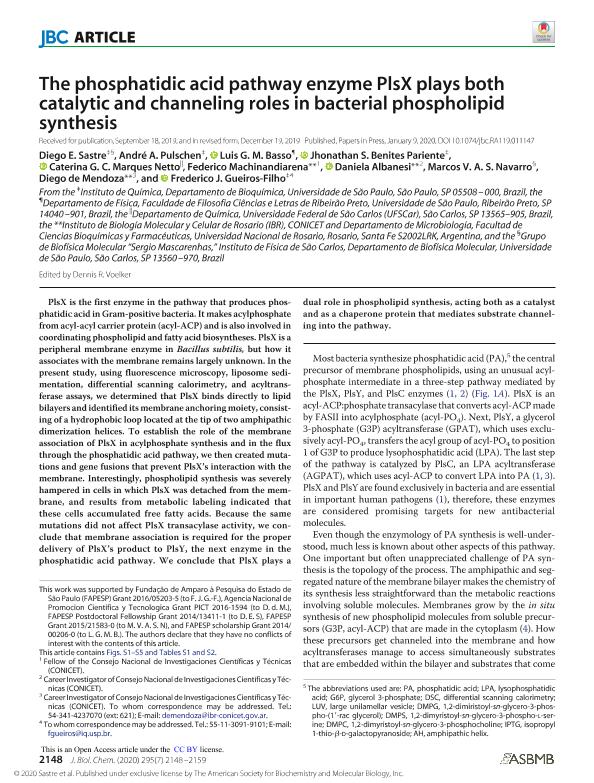Mostrar el registro sencillo del ítem
dc.contributor.author
Sastre, Diego Emiliano

dc.contributor.author
Pulschen, André A.
dc.contributor.author
Basso, Luis G.M.
dc.contributor.author
Benites Pariente, Jhonathan S.
dc.contributor.author
Marques Netto, Caterina G.C.
dc.contributor.author
Machinandiarena, Federico

dc.contributor.author
Albanesi, Daniela

dc.contributor.author
Navarro, Marcos V.A.S.
dc.contributor.author
de Mendoza, Diego

dc.contributor.author
Gueiros Filho, Frederico J.
dc.date.available
2023-01-27T18:20:03Z
dc.date.issued
2020-02
dc.identifier.citation
Sastre, Diego Emiliano; Pulschen, André A.; Basso, Luis G.M.; Benites Pariente, Jhonathan S.; Marques Netto, Caterina G.C.; et al.; The phosphatidic acid pathway enzyme PlsX plays both catalytic and channeling roles in bacterial phospholipid synthesis; Elsevier; Journal of Biological Chemistry (online); 295; 7; 2-2020; 2148-2159
dc.identifier.issn
0021-9258
dc.identifier.uri
http://hdl.handle.net/11336/185996
dc.description.abstract
PlsX is the first enzyme in the pathway that produces phosphatidic acid in Gram-positive bacteria. It makes acylphosphate from acyl-acyl carrier protein (acyl-ACP) and is also involved in coordinating phospholipid and fatty acid biosyntheses. PlsX is a peripheral membrane enzyme in Bacillus subtilis, but how it associates with the membrane remains largely unknown. In the present study, using fluorescence microscopy, liposome sedimentation, differential scanning calorimetry, and acyltransferase assays, we determined that PlsX binds directly to lipid bilayers and identified its membrane anchoring moiety, consisting of a hydrophobic loop located at the tip of two amphipathic dimerization helices. To establish the role of the membrane association of PlsX in acylphosphate synthesis and in the flux through the phosphatidic acid pathway, we then created mutations and gene fusions that prevent PlsX's interaction with the membrane. Interestingly, phospholipid synthesis was severely hampered in cells in which PlsX was detached from the membrane, and results from metabolic labeling indicated that these cells accumulated free fatty acids. Because the same mutations did not affect PlsX transacylase activity, we conclude that membrane association is required for the proper delivery of PlsX's product to PlsY, the next enzyme in the phosphatidic acid pathway. We conclude that PlsX plays a dual role in phospholipid synthesis, acting both as a catalyst and as a chaperone protein that mediates substrate channeling into the pathway.
dc.format
application/pdf
dc.language.iso
eng
dc.publisher
Elsevier

dc.rights
info:eu-repo/semantics/openAccess
dc.rights.uri
https://creativecommons.org/licenses/by/2.5/ar/
dc.subject
GLYCEROPHOSPHOLIPID
dc.subject
GRAM-POSITIVE BACTERIA
dc.subject
MEMBRANE BIOGENESIS
dc.subject
ACYLTRANSFERASE
dc.subject
LIPID BINDING PROTEIN
dc.subject
PLSX
dc.subject
ACYLPHOSPHATE
dc.subject
SUBSTRATE CHANNELING
dc.subject
PROTEIN-MEMBRANE INTERACTION
dc.subject
PHOSPHATIDIC ACID
dc.subject.classification
Bioquímica y Biología Molecular

dc.subject.classification
Ciencias Biológicas

dc.subject.classification
CIENCIAS NATURALES Y EXACTAS

dc.subject.classification
Biología Celular, Microbiología

dc.subject.classification
Ciencias Biológicas

dc.subject.classification
CIENCIAS NATURALES Y EXACTAS

dc.subject.classification
Biofísica

dc.subject.classification
Ciencias Biológicas

dc.subject.classification
CIENCIAS NATURALES Y EXACTAS

dc.title
The phosphatidic acid pathway enzyme PlsX plays both catalytic and channeling roles in bacterial phospholipid synthesis
dc.type
info:eu-repo/semantics/article
dc.type
info:ar-repo/semantics/artículo
dc.type
info:eu-repo/semantics/publishedVersion
dc.date.updated
2021-09-06T21:07:13Z
dc.identifier.eissn
1083-351X
dc.journal.volume
295
dc.journal.number
7
dc.journal.pagination
2148-2159
dc.journal.pais
Países Bajos

dc.journal.ciudad
Ámsterdam
dc.description.fil
Fil: Sastre, Diego Emiliano. Universidade de Sao Paulo; Brasil. Instituto de Química ; Universidade Do Sao Paulo;
dc.description.fil
Fil: Pulschen, André A.. Instituto de Química ; Universidade Do Sao Paulo;
dc.description.fil
Fil: Basso, Luis G.M.. Universidade de Sao Paulo; Brasil
dc.description.fil
Fil: Benites Pariente, Jhonathan S.. Instituto de Química ; Universidade Do Sao Paulo;
dc.description.fil
Fil: Marques Netto, Caterina G.C.. Universidade Federal do São Carlos; Brasil
dc.description.fil
Fil: Machinandiarena, Federico. Consejo Nacional de Investigaciones Científicas y Técnicas. Centro Científico Tecnológico Conicet - Rosario. Instituto de Biología Molecular y Celular de Rosario. Universidad Nacional de Rosario. Facultad de Ciencias Bioquímicas y Farmacéuticas. Instituto de Biología Molecular y Celular de Rosario; Argentina
dc.description.fil
Fil: Albanesi, Daniela. Consejo Nacional de Investigaciones Científicas y Técnicas. Centro Científico Tecnológico Conicet - Rosario. Instituto de Biología Molecular y Celular de Rosario. Universidad Nacional de Rosario. Facultad de Ciencias Bioquímicas y Farmacéuticas. Instituto de Biología Molecular y Celular de Rosario; Argentina
dc.description.fil
Fil: Navarro, Marcos V.A.S.. Universidade de Sao Paulo; Brasil
dc.description.fil
Fil: de Mendoza, Diego. Consejo Nacional de Investigaciones Científicas y Técnicas. Centro Científico Tecnológico Conicet - Rosario. Instituto de Biología Molecular y Celular de Rosario. Universidad Nacional de Rosario. Facultad de Ciencias Bioquímicas y Farmacéuticas. Instituto de Biología Molecular y Celular de Rosario; Argentina
dc.description.fil
Fil: Gueiros Filho, Frederico J.. Universidade de Sao Paulo; Brasil
dc.journal.title
Journal of Biological Chemistry (online)

dc.relation.alternativeid
info:eu-repo/semantics/altIdentifier/doi/http://dx.doi.org/10.1074/jbc.RA119.011147
dc.relation.alternativeid
info:eu-repo/semantics/altIdentifier/url/https://www.sciencedirect.com/science/article/pii/S0021925817482895
Archivos asociados
